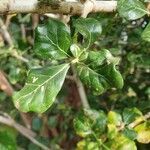Leaves tufted at the ends of short spreading lateral shoots which are arranged ternately; blades (0.8)2.5–9.5 × (0.8)1.7–5.5 cm, obovate or obcuneate and usually small when mature, mostly rounded at the apex, sometimes acute, distinctly cuneate at the base, occasionally crenate, (thinner in texture than in last species and with the venation finer and less prominent), glabrous or finely puberulous to slightly scabridulous; some young branchlets (particularly in the Flora Zambesiaca area) are distinctly heterophyllous with some leaves of very different shape, these leaves 8–18 × 1–5.4 cm, lanceolate to rhomboid-lanceolate; stipules 2–5 mm long, semi-circular to ovate-triangular, pubescent and ciliate; petiole 0–2(3) mm long.
A shrub or small tree. It can grow 10 m tall. The branches often arch over. The bark is smooth and light grey. The leaves are tufted at the ends of the short side shoots. They are 2.5-9.5 cm long by 1.7-5.5 cm wide. Leaves can vary in shape. Flowers occur singly and open at night. The flowers are white to yellow. The fruit are grey and 4-11 cm long by 3-10 cm wide. They have a woody wall.
Fruit usually whitish, grey or greyish-orange, very variable in size, 4–11 × 2.7–10 cm, ellipsoid to subglobose, usually with a thick fibrous or woody wall 3–10 mm thick, usually with prominent wart-like lenticels, not ribbed to very markedly coarsely 8–11-ribbed; apical and basal depressions in detached fruits wider than in last species, c. 15 mm; stalk thick, up to 13 mm wide.
Calyx tube 6–10 mm long, oblong, densely pubescent; limb-tube 5–14 mm long, glabrous or pubescent outside; lobes 7–9(10), extraordinarily variable, held at right angles to tube and decurrent, 2–15(20) × 0.5–8 mm, varying from small linear teeth to spathulate lobes or distinctly leaf-like, occasionally 2 joined to form a bifid lobe, glabrous, or limb ± truncate.
Trees or shrubs 0.9–10 m tall with thick crowns and occasionally arching branches which sometimes touch the ground; bark smooth, light grey, not breaking down to a powdery surface but sometimes flaking; branchlets pale, often greyish-white, glabrous or pubescent or puberulous only at the apices.
Corolla white or cream-coloured, turning yellow or orange, very variable in size; tube (2.5)5–12.5 cm long, very narrowly cylindrical, usually more slender than in last species, glabrous; lobes 6–9, 2–7 × 1–4.5 cm, elliptic to narrowly obovate.
Ovary with 6–9 placentas; style hairy, yellow-green; pollen presenter 4–7 mm long, 6–9-lobed, shortly exserted.
Seeds pale yellow-brown, more flattened than in last species, (4)5–10 mm long, finely reticulate-shagreened.
Anthers 1.3–2 cm long, inserted below the throat.
Flowers open at night, solitary.








